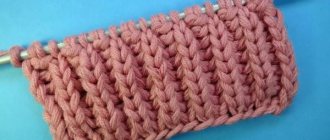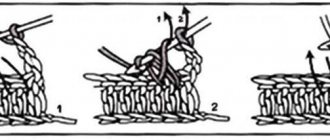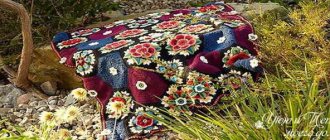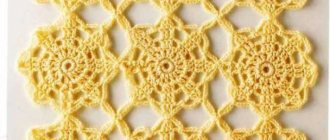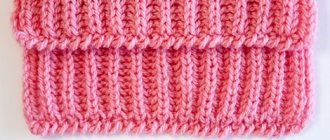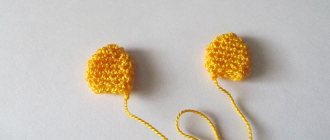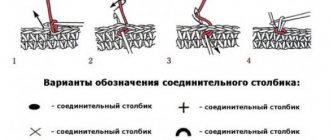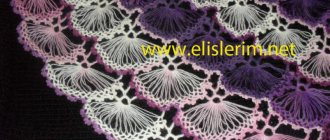- 29630
- 13-10-2020
- Author: Mysekret Team
- 0
Crocheted elastic is not just a cute relief pattern, but an important part of the product that has certain functional features. Elastic is an important component of most knitted clothing: sweaters, hats, skirts, mittens, socks. It is responsible for the elasticity of some elements of the product , while the dense woven structure allows you to maintain this function for a long time. Moreover, crocheted elastic bands are considered more accurate and elastic than knitted elastic bands.
Even this, at first glance, simple crochet pattern has its own knitting features, each of which allows you to achieve a different pattern on the elastic band as a result. In turn, each method of crocheting elastic assumes a different degree of elasticity and relief. To make it easier for beginning craftswomen to understand this, you need to familiarize yourself with the working technique and knitting patterns.
Crochet elastic bands with double crochets
An elastic band made from double crochets is knitted by alternating knit (convex) and purl (concave) relief stitches. You can see how to knit embossed columns in the article.
The first row of vertical elastic is knitted as an auxiliary row with regular double crochets. In the second row of the elastic band, start making embossed stitches, alternating: for example: 1 convex double crochet and 1 concave double crochet, this will be a 1x1 elastic band.
Crochet elastic pattern 1x1
Embossed rib stitches can be alternated in another way: 1x2, 1x3, 2x2, 3x2, etc. The first number is the number of convex (knit) double crochets, and the second number is the number of concave (purl) double crochets on the right side of the rib knitting.
Crochet elastic pattern 2x2
Establish a rhythm of alternating embossed columns and then knit the elastic “according to the pattern”, as the elastic columns look. Over a convex double crochet you need to knit a convex one, and over a concave double crochet you need to knit a concave one. The diagram shows patterns for crocheting elastic bands.
Do not forget that fabric knitted with an elastic band is highly compressed. Therefore, the first row of elastic must be knitted tightly. For knitting hats, try elastic patterns with air loops. This fabric turns out to be much softer and more elastic (Fig. 4-6).
Crochet elastic pattern with air loops
Video master - class on crocheting elastic bands
The video should load here, please wait or refresh the page.
Classic skirt
The crochet skirt, the diagrams and description for which can be seen below, is a classic model. It is intended for demi-season wear, as it is made of medium-thick yarn. This thread contains wool in varying percentages with other additives.
To avoid severe creasing of the finished product, it is recommended to use yarn whose wool content does not exceed 50%. To knit skirts from it, it is advisable to use hooks with numbers from 2 to 3. The resulting fabric will be quite dense and not loose, which will allow it to retain its shape.
To get started, you need to take measurements for further calculations:
- waist circumference;
- hip girth.
This should be done in order to determine the openings of the front, back and side darts.
To do this you need to do the following:
- Determine the difference in waist and hip measurements.
- Calculate the solution of the front darts, which is equal to 0.1% of the difference in size.
- Similarly, calculate the side and rear darts, each accounting for 0.2% of the same measurement.
- Be sure to check the correctness of the calculations by adding up all the dart solutions. The result should be the previously calculated difference between the measurements.
Classic crochet skirt - knitting patterns
Next, it is recommended to make a note where all the darts should be located. The front and back ones should be done at a distance of 10 cm from the midline of the skirt, and their length should be 10-12 cm in front and 12-14 in the back.
To make it easier to put on the skirt, a snake lock is sewn into the left side seam or a fastening bar is made. Therefore, during the execution process, the required distance in the side seam for this operation should be left open.
Before starting work, it is advisable to knit a small sample of the fabric to determine the density and convenience for calculations. Then you can start the main knitting. Depending on the direction of the process, the sequence of work is determined. The front and back panels of the skirt are made with single crochets.
If knitting is done from the top of the skirt, then you must first determine the location of the darts and mark them with markers. Using the sample, calculate in which rows you should add stitches in order to achieve the desired size. Then continue working with the usual cloth.
If you start knitting from the bottom, you should first measure the length of the skirt. Subtract the lengths of the darts from this measurement and knit them with fabric before starting.
Next, according to the calculated scheme, instead of adding, decrease loops. As a result, the resulting width of the product should be equal to the waist measurement.
After finishing knitting the main fabric, you can finish the bottom of the product. It can be performed either as a continuation of the skirt downwards or perpendicular to the main work. The presented model uses just such a harness. It should be knitted in the circle of the skirt, while simultaneously connecting to the bottom of the product.
The next model presented is also a classic skirt, but more lightweight. To knit it, it is recommended to use mercerized cotton yarn with the addition of viscose, which will provide the finished product with an excellent fit and the creation of identical tails. It is advisable to use hook number 3 for such threads.
The diagram uses the following symbols:
- double crochets,
- air loops,
- lush columns.
Classic crochet skirt - knitting patterns
This skirt should be knitted from the top edge, making a chain of air loops with a length equal to the circumference of the hips. The canvas can be made in one piece, in a circle, following the first pattern. But you should carefully ensure that the line connecting the rows is even.
After reaching the required length, you can begin to expand the skirt. It should be done according to the second scheme by adding loops in the openwork strip of the pattern. To give the finished product a finished look, belt loops and a cord-belt are knitted, which is threaded through them and tightens the skirt at the waist line.
Crocheting an elastic band with single crochets
This is a crochet version of the cross elastic, it can be knitted separately and then sewn to the product. Or start knitting a product with this elastic band, and continue knitting across, taking this elastic band as a base. You can do this with hats, mittens, and gloves. Of course, you cannot knit a sweater or blouse this way.
Crochet elastic patterns art. without crochet
Video tutorial on crocheting elastic bands
The video should load here, please wait or refresh the page.
Products of our needlewomen, crocheted with an elastic band
Crocheted beanie hat, Roxana's work
Crochet cardigan, Arina's work
Crochet headband and snood, work by Tatyana Erofeeva
Crocheted elastic band with double crochets
The third option for crochet cross elastic is art. with a crochet over the back half loop. In fact, this crochet elastic band itself is not very elastic; it is quite wide and does not cope well with the functions of an elastic band. This knitting method can be useful if you are knitting a product crosswise with an elastic band and you need to expand it. This could be a shirt-front, snood or crocheted gloves. The principle is the same as in the previous pattern, only replace the half double crochets with double crochets. In the work of Tatyana Erofeeva, the snood is crocheted with a transverse elastic band using double crochets.
The photo in the middle shows a sample crocheted from different elastic bands. First there are single crochets, then half double crochets and the last ones are double crochets. Due to this, the canvas expands:
Warm skirts
Also, warmer types of yarn with a weaker twist can be used to make demi-season and winter skirts. The numbers of hooks used increase, from No. 3 to No. 4.5 -5. They are knitted in several ways.
Below are 2 of them:
- made using patchwork technique;
- two panels of several colors;
- knitted from two-color motifs.
Using patchwork technique
This technique involves knitting a product from individual motifs, but they are performed not in the standard way from the center or from the initial row, but from corner to corner.
The motifs are sewn together at the end of the work, laid out in accordance with the drawing or diagram. Such motifs can be either monochromatic or consist of several colors. Each combination of different shades ultimately creates a unique visual pattern. The top of the skirt can be decorated with a narrow belt, made with single crochets.
Two panels of several colors
This model involves knitting a skirt from 3 colors, chosen at will. Having measured the circumference of the waist and hips and determined the knitting density, you can proceed to the main pattern.
From the diagram it can be seen that it consists of single crochets, with 1 double crochet, normal and knitted under the 2nd row below, as well as chain loops used when casting on the chain and lifting loops.
Multi-colored crochet skirt (knitting patterns)
The alternating color scheme of the pattern stripes is optional. After finishing knitting the front and back panels of the product, they are sewn together. The lower and upper edges of the skirt are decorated and subjected to wet processing. Decorate with a belt.
From two-color motifs
This model is also not difficult to make, but the finished product produces an unusual effect. It can be knitted from yarn of 2 contrasting colors or shades of the same color scheme. The result will be completely different.
The canvas of the product consists of separate motifs of flowers, changing places in each subsequent one. When performing the extreme row, they should be connected into one whole.
It is important to carefully monitor the placement of the motifs for each color option so as not to dissolve the work in case of an error. It is recommended to make a belt and a yoke for it, measuring 12-15 cm in height (measurement from the waist to the hip line) from one of the colors used. Next, connect it to the main fabric of the skirt.
Also tie the bottom edge with a row of single crochets in the color from which the belt is made. After finishing knitting, carry out wet-heat treatment of the finished product.
Using the proposed models, crocheted according to patterns and guided by descriptions and recommendations for the knitting process, you can create your own wardrobe of skirts for all seasons.
Crochet elastic band knitted with connecting posts
The connecting stitch (half-stitch, blind stitch) is knitted on the basis of the first row behind the back half-loop of the previous stitch. This elastic band is the densest and most similar to the one that is knitted, both in its properties and in appearance.
This is what the product looks like, knitted with a cross elastic band and connecting posts:
How to crochet such a beret with an elastic band.
Children's beanie WavyCat
Happy holidays to everyone! I want to wish you the warmest and most positive emotions, goodness and peace! And of course I don’t come to you empty-handed! In this post I want to show my new creation, a crochet hat WavyCat
Read more…
